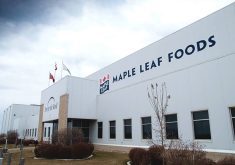It’s been decades in the works, but Manitoba’s first potash mine has cleared red tape and is on course to start production this fall.
In June, the provincial government announced that the Potash and Agri Development Corporation of Manitoba (PADCOM) had been granted all necessary permissions to start extraction and production in western Manitoba at its site 16 kilometres west of Russell, near the Saskatchewan border.
Saskatchewan has long been an international behemoth in terms of potash production. Potash operations across that province produce more than one billion tonnes per year. So, with an estimated annual production of 100,000 tonnes of potash per year — at least to begin with — the Manitoba mine is a relative drop in the bucket.
Read Also

Unclear food labels hinder Canada’s ‘buy local’ surge
“Maple-washing” on Canadian food packaging makes label claims hard to keep straight and hurts both farmers and consumers trying to buy Canadian, economist says.
While the project may not have a global impact, it will on a local level. At least, that’s the hope of PADCOM’s president, Daymon Guillas.
“There is great wealth associated with resource extraction, and there are certainly benefits to the community during the construction phase,” says Guillas.
The life of a mine can stretch for decades, so local benefits diminish quickly once construction is completed.
“We think we have a little better plan.”
That involves what Guillas calls “social royalties,” which will see a portion of net profit shared with the surrounding communities. This includes one per cent each for the local First Nations communities of Gambler, Waywayseecappo, Birdtail Sioux, Treaty Two Territory and the Manitoba Metis Federation. Another two per cent will go to a regional school program.
Four per cent will go to PADCOM’s economic development fund called ‘Impower.’
“It’s there to drive regional economic development,” says Guillas. “If you want to start a business at Waywayseecappo, Birdtail Sioux, Gambler, Russell or Binscarth, you can borrow money from this fund to start your business.”
That loan doesn’t have to be repaid, or at least not with dollars and cents.
“Impower doesn’t want the money back because it doesn’t need it. And we don’t want to put pressure on new businesses. So, what we’re asking people to do is to volunteer,” says Guillas.
It works like this: if someone borrows from the fund to start a business and the payments, including principal, interest and taxes, amount to $1,000 a month for 10 years, Impower would ask that the borrower pay it back through community volunteerism and submit their hours to Impower in lieu of payment.
“We just think it’s a kinder way to do it. It helps people get a leg up and it gets a bit more community engagement.”
It’s a unique business model, to be sure, and while he is clearly enthusiastic about the program, Guillas is quick to point out it wasn’t his idea. The idea of Impower is the brainchild of Rheanne Gray, who will serve as chairperson for the fund once it is running.
“So, this is hers,” says Guillas. “She said, ‘No Daymon, there’s a much better way to do business. Profit is necessary. But greed is wrong. And there is just a much kinder way to do it.’”
The idea of keeping the profits local goes beyond community outreach. The ownership group of the operation includes only shareholders from Manitoba and Saskatchewan, many from the surrounding communities.
“We’ve turned down investors from other countries and other provinces,” says Guillas.
One of the local shareholders is Gambler First Nation. The nearby Indigenous community invested $5 million, and for that, it is a 20 per cent equity owner of the mine. Guillas says the timing of the investment was important.
“It’s new technology, and there’s no project until the technology test is done. So, it’s hard to raise money. Gambler stepped up and they committed $5 million ‘at-risk’ money.”
The technology Guillas talks about is not entirely new. It’s based on a form of mineral extraction called “solution mining” that is commonly used in potash mining operations, where a brine is heated and injected into the deposit to dissolve the potash. The potash-rich brine is then pumped to the surface, where the water evaporates.
“I have no doubt that that’ll work because dissolving potash and bringing it to the surface has been done for 200 years,” says Guillas. “I think the big question is, what will the production be? Will these two wells produce the tonnage we expect?”
For those questions, Guillas defers to Harvey Haugen, president of Beechy Technologies and a partner in PADCOM. Haugen owns the technology and licences it to PADCOM.
“The key is that we’re using this selective solution mining called polythermic selective solution mining,” says Haugen.
This method is a variation on conventional solution mining. It has been around for a long time and is well understood, but this will be the first time it’s being used in practice.
“The hope in the ‘60s was that this is what they would use in Saskatchewan,” Haugen said. “It has dramatically reduced capital costs, dramatically reduced operating costs, and it doesn’t leave any tailings on site.”
It’s also revolutionary in terms of emissions. The company will be able to take advantage of Manitoba’s hydro-electric power and it also plans to use heat pumps for additional power savings. With those things included, the idea of a zero-carbon fertilizer is within reach.
“That’s been unattainable to date,” says Haugen.
The deposit is part of the same potash one that has been so productive on the other side of the Manitoba-Saskatchewan border. So, it is curious that it’s taken so long for anyone to set up a mine. Haugen says conventional mining methods wouldn’t have been feasible at the site.
“This particular property has been researched by a number of companies going back to the late ‘70s,” he said, but the resource in Manitoba is marginal.
“We’re right on the very edge of the deposit.”
The mine is expected to provide about 20 jobs in the area by October, when it is expected to begin operation. But Guillas reiterates that, while those jobs are an important part of PADCOM’s vision, the company recognizes the importance of a diverse, healthy economy that amplifies the strengths of the region.
“If our communities don’t stay stable, they dry up and go away. So, we have to have a vibrant business community. It is all about having a very strong quality of life and a very strong business district to support the tourism industry, the agricultural industry and now the mining and processing industry.”
















